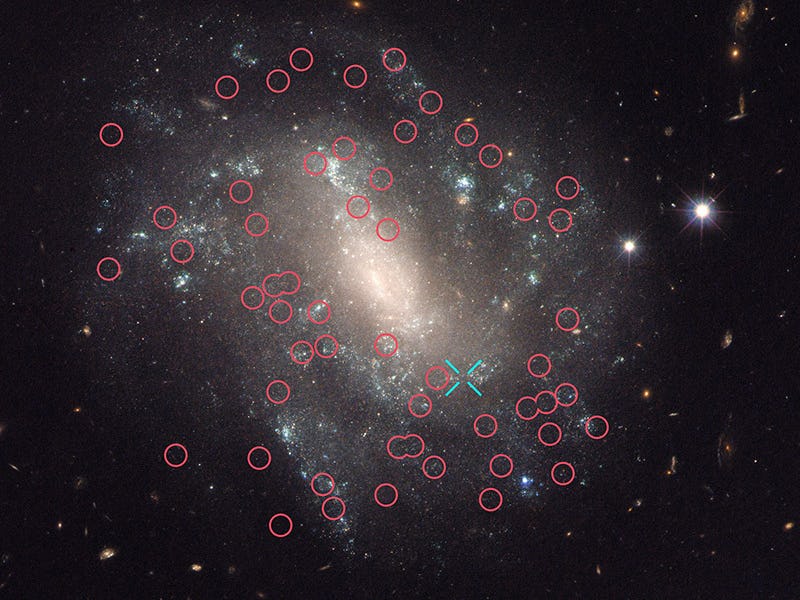The Universe Is Expanding Faster Than We Thought
Is it because of dark matter? Dark energy? Dark radiation? All of these above??

The universe is expanding five to nine percent faster than previously estimated, scientists have just learned. The reasons why are much less clear. The discrepancy between the new findings and previous numbers could be a result of dark matter, dark energy, dark radiation — or perhaps something else entirely.
Led by Nobel Laureate Adam Riess, a team of astronomers from Johns Hopkins University used the ol’ Hubble Space Telescope to collect new observations and calculate new expansion rates based on updated numbers. Those new rates are clearly higher than what scientists previously calculated based on measurements from the early universe, right after the Big Bang.
The results will appear in an upcoming issue of the Astrophysical Journal.
A perpetual goal among the scientific community is to narrow down all cosmological calculations such that the value of uncertainty is as low as possible. When it comes to expansion of the universe, scientists have “made a lot of progress,” Riess tells Inverse.
Unfortunately, there are still too many unknown variables that make it hard to pinpoint an exact value onto many astrophysical processes. Scientists are forced to fill these gaps of “naive conceptions” with estimations and guesswork.
How the researcher used brightness and distance values to calculate a new Hubble's constant.
But learning to take more precise measurements helps to fill these gaps. Riess and his team successfully reduced what’s known as Hubble’s constant down to an uncertainty of just 2.4 percent, by using new techniques in measuring the distance of faraway galaxies. The team narrowed their observations by focusing on galaxies with Cepheid stars — which pulsate at rates that correspond closely to their true brightnesses — and Type la supernovae — which flare up with the same brightness as their former life as stars and are glow for large distances.
The JHU team measured the brightness 2,400 Cepheid stars in 19 galaxies and compared them to other calculated distances of about 300 Type la supernovae and determined the expansion of space through the stretching of light from receding galaxies. Combined, Riess and his colleagues were able to recalculate Hubble’s constant to about 73.2 kilometers per second per megaparsec. In layman’s terms, this means the universe is expanding at a rate where the distance between objects in space will double in another 9.8 billion years.
Unfortunately, while the new value is more accurate, it introduces a puzzle: why were previous expansion rates — namely those using data from NASA’s Wilkinson Microwave Anisotropy Probe, and ESA’s Planck satellite mission — lower? Those were derived from investigations of the universe as a wee lil’ baby. What’s changed since then?
Dark stuff, maybe — which makes up about 95 percent of the universe. “We don’t really understand the physics of these dark parts,” says Riess.
A Hubble Space Telescope image of the galaxy UGC 9391, one of the galaxies in the new survey. UGC 9391 contains the two types of stars – Cepheid variables and a Type 1a supernova – that astronomers used to calculate a more precise Hubble constant. Click on the image to see the red circles that mark the locations of Cepheids. The blue “X” denotes the location of supernova 2003du, a Type Ia supernova. The observations for this composite image were taken between 2012 and 2013 by Hubble’s Wide Field Camera 3.
Dark matter would interact with the universe’s expansion by creating retractive gravity that slows expansion down. Dark energy, by contrast, would create repulsive gravity that speeds up expansion. And dark radiation — thought to be the collective force of a subatomic particle that was more significant in the early history of the universe, may have affected expansion of the universe during its early days, but later tapered off as those particles fanned out.
Exactly which is it, however, is unclear. “We need more clues to pinpoint which it is,” says Riess. While we are able to observe these phenomena based on their effects on what we can see, we’ve never directly observed or measured the darker parts of the universe. “We are lacking the theoretical underpinnings” that support our understanding for how dark matter, dark energy, and dark radiation behaves, he says.
That might change soon thanks to newer technologies. The Hubble Space Telescope is an obscene 26 years old — basically Skeletor by spacecraft standards. The fact that the JHU team was able to use it to refine the expansion rates is incredible — but it goes without saying better technology would help improve that value even more. The James Webb Space Telescope will be the most powerful space instrument ever made when it launches in 2018 — and it will almost surely give us a better glimpse of the aforementioned light and distance data than ever before.
When it comes to directly investigating dark energy and matter, NASA’s Wide Field Infrared Survey Telescope could be key in helping us to find dark energy. And of course, the search for dark matter is only engrossing more and more segments of the scientific community.